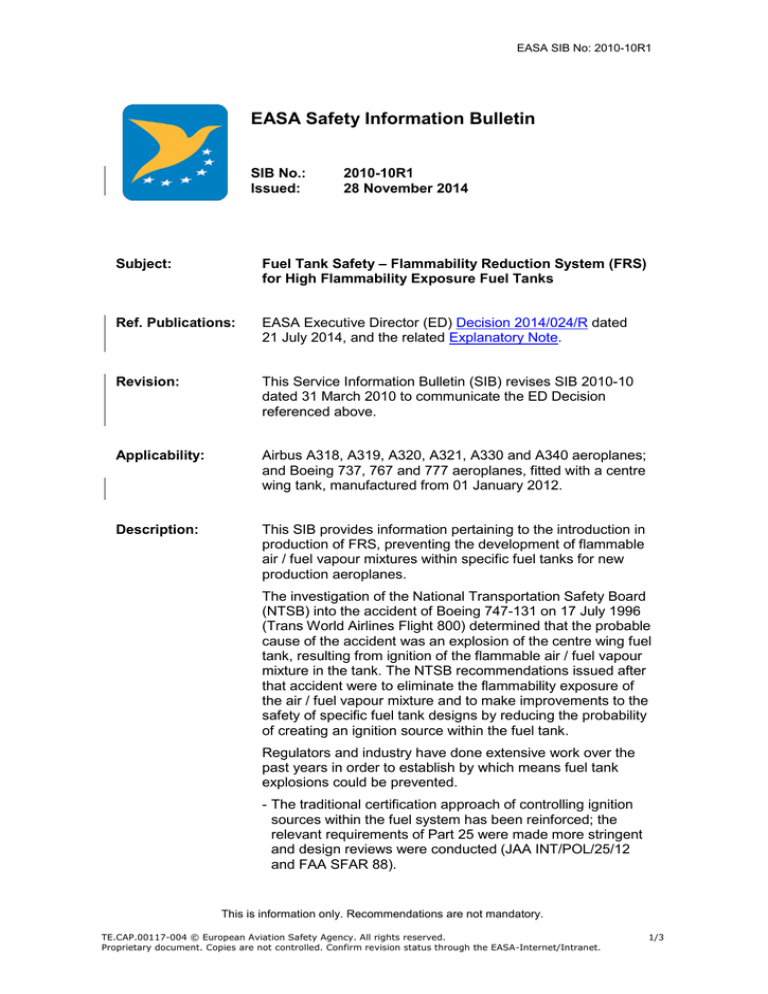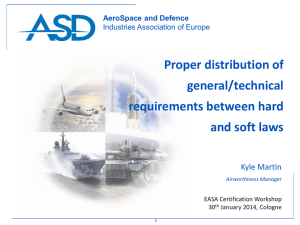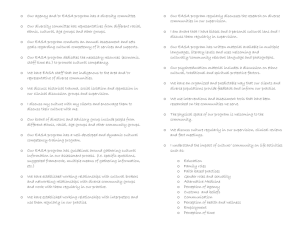
EASA SIB No: 2010-10R1
EASA Safety Information Bulletin
SIB No.:
Issued:
2010-10R1
28 November 2014
Subject:
Fuel Tank Safety – Flammability Reduction System (FRS)
for High Flammability Exposure Fuel Tanks
Ref. Publications:
EASA Executive Director (ED) Decision 2014/024/R dated
21 July 2014, and the related Explanatory Note.
Revision:
This Service Information Bulletin (SIB) revises SIB 2010-10
dated 31 March 2010 to communicate the ED Decision
referenced above.
Applicability:
Airbus A318, A319, A320, A321, A330 and A340 aeroplanes;
and Boeing 737, 767 and 777 aeroplanes, fitted with a centre
wing tank, manufactured from 01 January 2012.
Description:
This SIB provides information pertaining to the introduction in
production of FRS, preventing the development of flammable
air / fuel vapour mixtures within specific fuel tanks for new
production aeroplanes.
The investigation of the National Transportation Safety Board
(NTSB) into the accident of Boeing 747-131 on 17 July 1996
(Trans World Airlines Flight 800) determined that the probable
cause of the accident was an explosion of the centre wing fuel
tank, resulting from ignition of the flammable air / fuel vapour
mixture in the tank. The NTSB recommendations issued after
that accident were to eliminate the flammability exposure of
the air / fuel vapour mixture and to make improvements to the
safety of specific fuel tank designs by reducing the probability
of creating an ignition source within the fuel tank.
Regulators and industry have done extensive work over the
past years in order to establish by which means fuel tank
explosions could be prevented.
- The traditional certification approach of controlling ignition
sources within the fuel system has been reinforced; the
relevant requirements of Part 25 were made more stringent
and design reviews were conducted (JAA INT/POL/25/12
and FAA SFAR 88).
This is information only. Recommendations are not mandatory.
TE.CAP.00117-004 © European Aviation Safety Agency. All rights reserved.
Proprietary document. Copies are not controlled. Confirm revision status through the EASA-Internet/Intranet.
1/3
EASA SIB No: 2010-10R1
- Regarding the flammability exposure of the air / fuel vapour
mixture, requirements applicable to new designs were
published in CS 25 Amendment 1, revised in Amendment 6.
For in-service products, in 2004 and 2008 EASA conducted
two Regulatory Impact Assessments (RIAs). In accordance
with the RIAs’ conclusions, EASA determined that, in order to
improve the overall fuel tank safety level, from 01 January
2012 at the latest, all new production airframes having a fuel
tank with a high flammability exposure should be fitted with
FRS.
National Aviation Authorities and Operators should therefore
be aware that:
- The FRS, when installed in production, becomes part of the
aeroplane minimum configuration. It must therefore remain
installed and can only be dispatched inoperative in
accordance with the provisions of the approved Master
Minimum Equipment List (MMEL).
- No large transport aeroplane having made its first flight after
31 December 2011 will feature a fuel tank with a high
flammability exposure, unless this tank is fitted with FRS.
A high flammability exposure tank is defined by having a fleet
average flammability exposure level exceeding 7%. The fleet
average flammability exposure is determined in accordance
with appendix N of CS 25 at Amendment 6.
The flammability exposure of current large transport
aeroplanes fuel tanks were assessed for showing compliance
with FAR 26.33. The centre wing tank of the following models
were identified as having a fleet average flammability
exposure above 7% (the table lists models still in production
at the end of 2011):
Airbus
TCDS
A318, A319, A320 and A321
EASA.A.064
A330
EASA.A.004
A340
EASA.A.015
Boeing
737-600, -700, -800 and -900
EASA.IM.A.120
767
EASA.IM.A.035
777
EASA.IM.A.003
Both aeroplane manufacturers have developed FRS using
nitrogen enriched air produced by air separation module
filtering engine bleed air, and have introduced FRS in
production on the affected aeroplane types.
The relevant Type Certificate Data Sheets (TCDS, see
references in Table above) have been amended to record the
type definition update for new production aeroplanes,
associated with the introduction of FRS.
This is information only. Recommendations are not mandatory.
TE.CAP.00117-004 © European Aviation Safety Agency. All rights reserved.
Proprietary document. Copies are not controlled. Confirm revision status through the EASA-Internet/Intranet.
2/3
EASA SIB No: 2010-10R1
Based on the outcome of a Regulatory Impact Assessment,
EASA have decided (See ED Decision 2014/024/R
referenced above) not to include FRS retrofit into the
forthcoming Part 26 / CS 26, as originally envisaged, nor are
there any other plans to require retro-active modification to
install FRS on in-service aeroplanes registered in EASA
Member States.
At this time, consistent with the ED Decision, the safety
concern described in this SIB is not considered to be an
unsafe condition that would warrant Airworthiness Directive
(AD) action under Commission Regulation (EU) No 748/2012,
Part 21.A.3B.
Contact(s):
For further information contact the Safety Information Section,
Certification Directorate, EASA. E-mail: ADs@easa.europa.eu.
For Boeing service information related to this SIB, contact Boeing
Commercial Airplanes, Attention: Data & Services Management,
P.O. Box 3707, MC 2H-65, Seattle, Washington 98124-2207,
United States of America; Telephone +1 206-544-5000, ext. 1;
Fax +1 206-766-5680; Internet https://www.myboeingfleet.com.
For Airbus service information related to this SIB, contact the
relevant Airworthiness Office, as applicable:
A318/A319/A320/A321: account.airworth-eas@airbus.com.
A330/A340: airworthiness.A330-A340@airbus.com.
Internet: https://w3.airbus.com.
This is information only. Recommendations are not mandatory.
TE.CAP.00117-004 © European Aviation Safety Agency. All rights reserved.
Proprietary document. Copies are not controlled. Confirm revision status through the EASA-Internet/Intranet.
3/3





